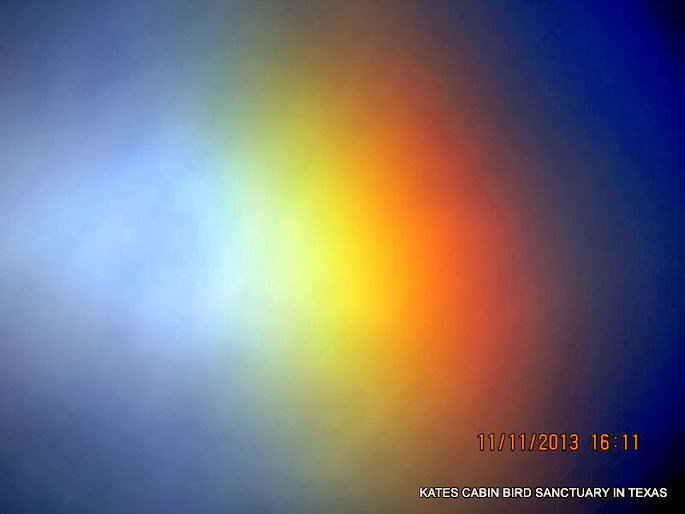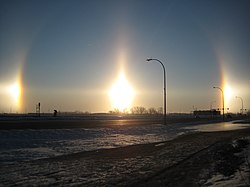
Hi Everybody!!
Back in the Day, (the very early days), these optical phenomenon were viewed as Miracles. Today we know these are just Sun Dogs and Ice Halos by the Sun!! And, I double dog dare You to shoot some (with your camera). Below I have shared info from Wikipedia regarding some of these rare sightings. Also, You will find links to 2 G+ Photo Albums with extended photostudies on sun dogs and halos of this November 2013. Enjoy!


https://en.wikipedia.org/wiki/Sun_dog
Sun dog
From Wikipedia, the free encyclopedia
A sun dog or sundog, scientific name parhelion (plural parhelia) from Greekπαρήλιον (parēlion), meaning "beside the sun"; from παρά (para), meaning "beside", and ἥλιος (helios), meaning "sun", also called a mock sun[1] or a phantom sun,[2]is an atmospheric phenomenon that creates bright spots of light in the sky, often on a luminous ring or halo on either side of the sun.[3]
Sundogs may appear as a colored patch of light to the left or right of the sun, 22° distant and at the same distance above the horizon as the sun, and in ice halos. They can be seen anywhere in the world during any season, but they are not always obvious or bright. Sundogs are best seen and are most conspicuous when the sun is low.

Very bright sundogs in Fargo, North Dakota. Note the halo arcs passing through each sundog.
Formation and characteristics[edit]
Sundogs are commonly made by the refraction of light from plate-shaped hexagonal ice crystals in high and cold cirrus clouds or, during very cold weather, these ice crystals are called diamond dust, and drift in the air at low levels. These crystals act as prisms, bending the light rays passing through them with a minimum deflection of 22°. If the crystals are randomly oriented, a complete ring around the sun is seen — a halo. But often, as the crystals sink through the air, they become vertically aligned, so sunlight is refracted horizontally — in this case, sundogs are seen.
As the sun rises higher, the rays passing through the crystals are increasingly skewed from the horizontal plane. Their angle of deviation increases, and the sundogs move further from the sun.[4] However, they always stay at the same elevation as the sun.
Sundogs are red-colored at the side nearest the sun. Farther out the colors grade through oranges to blue. However, the colors overlap considerably and so are muted, never pure or saturated. The colors of the sundog finally merge into the white of the parhelic circle (if the latter is visible).
It is theoretically possible to predict the forms of sundogs as would be seen on other planets and moons. Mars might have sundogs formed by both water-ice and CO2-ice. On the giant gas planets — Jupiter, Saturn, Uranus and Neptune — other crystals form the clouds of ammonia, methane, and other substances that can produce halos with four or more sundogs.[5]

*Link to extended photostudy (more sun dogs):
https://plus.google.com/photos/117645114459863049265/albums/5945857772522248273

Sun Halos


https://en.wikipedia.org/wiki/Halo_(optical_phenomenon)
Halo (optical phenomenon)
From Wikipedia, the free encyclopedia
A halo (from Greek ἅλως; also known as a nimbus, icebow or gloriole) is an optical phenomenon produced by ice crystals creating colored or white arcs and spots in the sky. Many are near the sun or moon but others are elsewhere and even in the opposite part of the sky. They can also form around artificial lights in very cold weather when ice crystals called diamond dust are floating in the nearby air.
There are many types of ice halos. They are produced by the ice crystals in cirrostratus clouds high (5–10 km, or 3–6 miles) in the upper troposphere. The particular shape and orientation of the crystals is responsible for the type of halo observed. Light is reflectedand refracted by the ice crystals and may split up into colors because of dispersion. The crystals behave like prisms and mirrors, refracting and reflecting sunlight between their faces, sending shafts of light in particular directions.
Atmospheric phenomena such as halos were used as part of weather lore as an empiricalmeans of weather forecasting before meteorology was developed. They often do mean that rain is going to fall within the next 24 hours as the cirrostratus clouds that cause them can signify an approaching frontal system.
Other common optical phenomena involving water droplets rather than ice crystals include the glory and the rainbow.







*Link to extended photostudy (more sun halos):
https://plus.google.com/photos/117645114459863049265/albums/5945926626654618561




...this is brendasue signing off from Rainbow Creek. See You next time!!!
Keep an eye to the Sky!!!!!!!!
O+O


No comments:
Post a Comment
Hi Everybody! Please say hello and follow so I know you are here! Due to the inconsideration of people trying to put commercials on my blog comment area, I have restricted use of anonymous posts. Sorry that some hurt all.
My public email is katescabin@gmail.com No spammers or trolls